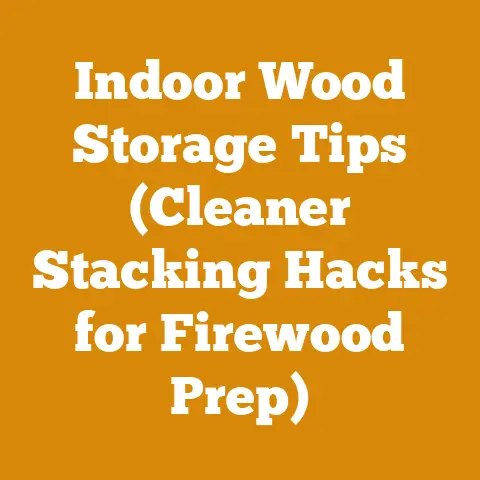Cleaning a Chimney Flue: Basement Access Tips (Pro Wood Heat Hacks)
Ah, the satisfying crackle of a wood fire on a cold winter’s night – it’s a sound that resonates deep within the soul. But that cozy warmth comes with a responsibility: maintaining your chimney flue. Over the years, I’ve seen firsthand the consequences of neglecting this crucial task. From minor smoke issues to full-blown chimney fires, the risks are real. Today, I want to share my knowledge and experience, focusing specifically on cleaning your chimney flue when you have basement access. This isn’t just about ticking off a chore; it’s about safeguarding your home and family. I’ll walk you through the process, offering practical tips, safety precautions, and insights I’ve gleaned from years of working with wood and heating systems. Let’s dive in and ensure your wood-burning season is safe and enjoyable.
Cleaning a Chimney Flue: Basement Access Tips (Pro Wood Heat Hacks)
Having basement access to your chimney flue makes cleaning significantly easier. No more precarious climbs onto the roof! However, convenience shouldn’t compromise safety or thoroughness. I’ll guide you through a step-by-step process, highlighting essential tools, safety protocols, and pro tips I’ve learned over the years.
Understanding the Importance of Chimney Cleaning
Before we get our hands dirty, let’s understand why chimney cleaning is so vital. Creosote, a byproduct of burning wood, builds up inside your chimney flue. This substance is highly flammable. According to the National Fire Protection Association (NFPA), chimney fires are a leading cause of residential fires, often stemming from creosote buildup. Regular cleaning removes this hazard, ensuring a safe and efficient heating system.
Beyond fire prevention, a clean chimney improves draft. A buildup of soot and creosote restricts airflow, making it harder to start and maintain a fire. This can lead to smoke backing up into your home, which is not only unpleasant but also poses a health risk due to carbon monoxide exposure.
Assessing Your Chimney’s Condition
Before you even think about cleaning, take a good look at your chimney. Use a flashlight to examine the flue from the basement access point. Look for:
- Creosote buildup: Is it a light, powdery soot, or a thick, tarry glaze? The type and amount of creosote will influence your cleaning approach.
- Cracks or damage: Any signs of cracks, crumbling mortar, or other structural issues should be addressed by a professional before using the fireplace. Ignoring these problems can lead to more significant and costly repairs down the line.
- Obstructions: Bird nests, leaves, or other debris can block the flue. These need to be removed before cleaning. I once found a family of squirrels had taken up residence in a chimney I was inspecting!
If you spot any serious damage or have concerns about the chimney’s structural integrity, call a certified chimney sweep. It’s better to be safe than sorry.
Gathering Your Tools and Supplies
Having the right tools makes the job much easier and safer. Here’s what I recommend:
- Chimney brush: Choose a brush that’s the correct size and shape for your flue. Round brushes are suitable for round flues, while square or rectangular brushes are needed for those shapes. The brush should fit snugly but not be so tight that it’s difficult to maneuver.
- Extension rods: These connect to your chimney brush, allowing you to reach the entire length of the flue from the basement. Get enough rods to cover the height of your chimney, plus a few extra for good measure.
- Drop cloths: Protect your flooring and furniture from soot and debris. Place drop cloths around the fireplace opening and in the basement area where you’ll be working.
- Dust mask or respirator: Protect your lungs from inhaling soot and dust particles. A dust mask is better than nothing, but a respirator provides superior protection.
- Safety glasses: Prevent soot and debris from getting into your eyes.
- Gloves: Protect your hands from getting dirty and scratched.
- Shop vacuum: A shop vacuum is essential for cleaning up the soot and debris that falls into the fireplace and basement.
- Chimney scraper (optional): If you have a significant buildup of hard, glazed creosote, a chimney scraper can help loosen it before brushing.
- Mirror: A small mirror can be helpful for inspecting the flue from below.
- Duct tape: For sealing off the fireplace opening.
- Flashlight: For illuminating the flue.
Preparing the Area
Before you start cleaning, take the time to prepare the area. This will minimize mess and make the job more efficient.
- Remove flammable materials: Clear away any flammable materials from the fireplace area, such as curtains, rugs, and furniture.
- Seal off the fireplace opening: Use duct tape and plastic sheeting to seal off the fireplace opening. This will prevent soot and debris from escaping into your home.
- Open a window: Provide ventilation to help clear out dust and fumes.
- Turn off the furnace: Prevent any backdrafts.
- Inform household members: Let everyone in the house know you’ll be cleaning the chimney and that they should avoid using the fireplace.
Step-by-Step Cleaning Process
Now, let’s get down to the nitty-gritty. Here’s a step-by-step guide to cleaning your chimney flue from the basement:
- Access the Cleanout: Locate the cleanout door in your basement. This is usually a small metal door at the base of the chimney.
- Carefully Open the Cleanout: Wear your safety glasses and dust mask. Slowly open the cleanout door. Be prepared for soot and debris to fall out.
- Assemble the Brush and Rods: Attach the chimney brush to one extension rod.
- Insert the Brush: Insert the brush into the flue through the cleanout opening.
- Push and Twist: Push the brush upwards, twisting it as you go. This will help loosen the creosote and soot.
- Add Rods: As you push the brush further up the flue, add more extension rods.
- Clean the Entire Flue: Continue pushing and twisting the brush until you reach the top of the chimney.
- Reverse the Process: Slowly pull the brush back down, twisting it as you go. Remove the extension rods as you go.
- Inspect the Flue: Use a flashlight and mirror to inspect the flue. Make sure you’ve removed all the creosote and soot. If necessary, repeat the cleaning process.
- Vacuum the Debris: Use a shop vacuum to clean up the soot and debris that has fallen into the fireplace and basement.
- Clean the Cleanout: Thoroughly clean the cleanout area, removing all traces of soot and debris.
- Close the Cleanout: Securely close the cleanout door.
- Remove the Seal: Carefully remove the plastic sheeting and duct tape from the fireplace opening.
- Inspect the Fireplace: Check the fireplace for any remaining soot or debris. Vacuum as needed.
- Dispose of Debris: Properly dispose of the soot and debris. Place it in a sealed bag and discard it in a non-combustible container.
- Ventilate the Area: Open windows and doors to ventilate the area and remove any remaining dust or fumes.
Dealing with Stubborn Creosote
Sometimes, you’ll encounter stubborn creosote that’s difficult to remove with just a brush. Here are some tips for dealing with it:
- Chimney Scraper: Use a chimney scraper to loosen the hard, glazed creosote before brushing.
- Creosote Remover: Apply a chemical creosote remover according to the manufacturer’s instructions. These products can help break down the creosote, making it easier to remove. I’ve had decent success with some of the spray-on types, but always follow the safety guidelines meticulously.
- Professional Help: If you’re unable to remove the stubborn creosote yourself, call a certified chimney sweep. They have specialized tools and techniques for dealing with difficult creosote buildup.
Safety Precautions
Chimney cleaning can be a dirty and potentially dangerous job. Here are some essential safety precautions to keep in mind:
- Wear protective gear: Always wear safety glasses, a dust mask or respirator, and gloves.
- Work in a well-ventilated area: Open windows and doors to provide ventilation.
- Avoid working alone: Have someone nearby in case of an emergency.
- Be careful when handling tools: Use caution when using the chimney brush, extension rods, and scraper.
- Never use water to clean the chimney: Water can damage the chimney liner and create a dangerous situation.
- If you’re uncomfortable with any part of the process, call a certified chimney sweep.
Maintaining Your Chimney
Regular chimney cleaning is essential, but it’s not the only aspect of chimney maintenance. Here are some additional tips for keeping your chimney in good condition:
- Burn seasoned wood: Seasoned wood burns hotter and cleaner than green wood, producing less creosote. Aim for a moisture content of 20% or less. I always tell people, the best way to season wood is to stack it properly for at least six months, preferably a year. Good airflow is key!
- Avoid burning trash or treated wood: Burning these materials can produce harmful chemicals and excessive creosote.
- Have your chimney inspected annually: A certified chimney sweep can inspect your chimney for any signs of damage or deterioration.
- Repair any damage promptly: Address any cracks, crumbling mortar, or other issues as soon as possible.
- Consider a chimney cap: A chimney cap can prevent rain, snow, and debris from entering the chimney. It also helps prevent downdrafts.
Optimizing Wood Burning for Reduced Creosote
The way you burn wood significantly impacts creosote buildup. Here’s how to optimize your burning practices:
- Hot Fires: Maintain hotter fires. Low, smoldering fires produce more smoke and creosote. Aim for a bright, clean flame.
- Air Control: Use your fireplace’s air controls to regulate the fire’s intensity. Don’t damper down the fire too much, as this restricts airflow and increases creosote production.
- Top-Down Burning: Consider using a top-down burning method. This involves stacking the wood with kindling on top, which promotes a cleaner burn.
- Regular Inspections: Check your chimney flue regularly for creosote buildup. The more often you check, the sooner you can detect any issues.
Cost Savings from DIY Chimney Cleaning
Cleaning your chimney yourself can save you money. A professional chimney sweep typically charges between \$150 and \$300 for a standard cleaning. By doing it yourself, you can save this money and put it towards other home maintenance projects. However, remember that safety is paramount. If you’re not comfortable with the process, it’s always best to hire a professional.
Case Study: A Creosote Nightmare Averted
I once had a client who had been burning wood in their fireplace for years without ever cleaning the chimney. They noticed a strange smell coming from the fireplace, but they ignored it. One day, they heard a loud crackling sound coming from the chimney. They quickly realized that a chimney fire had started. Fortunately, they were able to extinguish the fire before it spread to the rest of the house. However, the chimney was severely damaged, and they had to pay thousands of dollars for repairs. This incident highlights the importance of regular chimney cleaning. Had they cleaned their chimney regularly, they could have prevented the fire and saved themselves a lot of money and stress. This is why I am so passionate about sharing this knowledge.
Choosing the Right Chimney Brush
Selecting the correct chimney brush is crucial for effective cleaning and preventing damage to your flue. Consider these factors:
- Flue Shape and Size: Match the brush shape (round, square, or rectangular) to your flue’s shape. Measure the flue’s dimensions to ensure a snug but not overly tight fit.
- Brush Material: Wire brushes are suitable for masonry chimneys, while poly brushes are recommended for metal flues to avoid scratching or damaging the liner.
- Rod Flexibility: Choose rods that are flexible enough to navigate bends in your chimney but sturdy enough to provide adequate pushing power.
- Brush Head Type: Some brushes have a single head, while others have multiple heads for more aggressive cleaning. Consider the level of creosote buildup when choosing a brush head type.
Understanding Different Types of Creosote
Creosote isn’t a uniform substance. It exists in different forms, each posing varying levels of risk and requiring different cleaning approaches:
- Stage 1 (Light and Powdery): This is the least hazardous form and is relatively easy to remove with a brush.
- Stage 2 (Flaky and Granular): This form is more difficult to remove than Stage 1 creosote. It requires more aggressive brushing and may necessitate the use of a chimney scraper.
- Stage 3 (Hard and Glazed): This is the most dangerous form of creosote. It’s extremely difficult to remove and poses a significant fire hazard. Chemical creosote removers or professional cleaning may be required.
The Impact of Wood Moisture Content
The moisture content of the wood you burn directly affects creosote production. Burning wet or unseasoned wood leads to:
- Increased Smoke: Wet wood produces significantly more smoke, which carries more creosote particles into the chimney.
- Lower Burning Temperatures: The energy used to evaporate the water in wet wood lowers the overall burning temperature, leading to incomplete combustion and increased creosote formation.
- Condensation: Water vapor in the smoke condenses in the chimney, mixing with soot and creosote to form a sticky, flammable residue.
Aim for a wood moisture content of 20% or less. Use a moisture meter to check the moisture level of your wood before burning it. I test every load of wood I bring into my house.
Sustainable Wood Sourcing
As wood burners, we have a responsibility to source our wood sustainably. Here are some tips:
- Buy Local: Purchase wood from local suppliers who practice sustainable forestry management.
- Harvest Responsibly: If you harvest your own wood, follow sustainable harvesting practices. This includes selecting trees carefully, avoiding over-harvesting, and replanting trees as needed.
- Consider Alternative Fuels: Explore alternative fuels such as wood pellets or manufactured logs, which can be more efficient and produce less creosote.
The Role of Chimney Caps
A chimney cap is a simple but effective device that protects your chimney from the elements and helps prevent problems:
- Keeps Out Rain and Snow: Rain and snow can damage the chimney liner and create moisture problems.
- Prevents Debris from Entering: Leaves, twigs, and animal nests can block the flue and create a fire hazard.
- Prevents Downdrafts: A chimney cap can help prevent downdrafts, which can cause smoke to back up into your home.
- Spark Arrestor: Many chimney caps include a spark arrestor, which prevents sparks from escaping the chimney and potentially igniting nearby vegetation.
Identifying and Addressing Chimney Draft Issues
A properly functioning chimney draft is essential for safe and efficient wood burning. Here are some common draft issues and how to address them:
- Weak Draft: A weak draft can cause smoke to back up into your home. This can be caused by a blocked flue, a cold chimney, or a negative pressure situation in your home.
- Strong Draft: A strong draft can cause the fire to burn too quickly and inefficiently. This can be caused by an oversized chimney or a lack of air control in the fireplace.
- Downdrafts: Downdrafts occur when air flows down the chimney instead of up. This can be caused by wind conditions, nearby obstructions, or a poorly designed chimney.
To improve your chimney’s draft, try these solutions:
- Ensure the Flue is Clean: A clean flue is essential for proper draft.
- Warm the Chimney: Before starting a fire, warm the chimney by burning a small amount of paper or kindling.
- Adjust Air Controls: Use the fireplace’s air controls to regulate the draft.
- Install a Chimney Cap: A chimney cap can help prevent downdrafts.
- Consider a Chimney Extension: If your chimney is too short, consider adding an extension to improve the draft.
Understanding the Science of Combustion
A basic understanding of combustion can help you burn wood more efficiently and reduce creosote production. Combustion is a chemical process that involves the rapid oxidation of fuel, releasing heat and light. For complete combustion to occur, three elements are needed:
- Fuel: The wood you burn.
- Oxygen: The air that feeds the fire.
- Heat: The temperature required to ignite the fuel.
When combustion is incomplete, it produces smoke, creosote, and other harmful byproducts. By ensuring that all three elements are present in sufficient quantities, you can achieve more complete combustion and reduce creosote buildup.
The Importance of Regular Chimney Inspections
Even if you clean your chimney regularly, it’s still essential to have it inspected by a certified chimney sweep annually. A professional inspection can identify potential problems that you might miss, such as:
- Cracks or Damage to the Chimney Liner: A damaged liner can allow harmful gases to leak into your home.
- Water Damage: Water damage can weaken the chimney structure and lead to costly repairs.
- Blockages: A professional inspection can identify any blockages in the flue, such as bird nests or debris.
- Creosote Buildup: A professional inspection can assess the level of creosote buildup and recommend the appropriate cleaning method.
A chimney inspection is a relatively inexpensive way to ensure the safety and efficiency of your heating system.
Addressing Common Chimney Problems
Here are some common chimney problems and how to address them:
- Smoke Backing Up into the House: This can be caused by a blocked flue, a weak draft, or a negative pressure situation in your home.
- Chimney Leaks: Chimney leaks can be caused by damaged flashing, cracks in the chimney crown, or a deteriorated chimney liner.
- Crumbling Mortar: Crumbling mortar can weaken the chimney structure and allow water to penetrate.
- Animal Infestation: Animals such as birds, squirrels, and raccoons can nest in chimneys.
Utilizing Technology for Firewood Preparation
Modern technology can significantly improve the efficiency and safety of firewood preparation. Here are some examples:
- Moisture Meters: Digital moisture meters provide accurate readings of wood moisture content, ensuring you burn seasoned wood.
- Chainsaw Sharpeners: Electric chainsaw sharpeners make it easier to maintain a sharp chain, improving cutting efficiency and safety.
- Log Splitters: Hydraulic log splitters reduce the physical strain of splitting wood and can significantly increase productivity.
- Firewood Processors: These machines automate the entire firewood preparation process, from log cutting to splitting and stacking.
Ergonomics in Wood Processing
Wood processing can be physically demanding. Practicing good ergonomics can help prevent injuries and improve efficiency:
- Proper Lifting Techniques: Use your legs, not your back, when lifting heavy logs. Keep your back straight and your core engaged.
- Adjust Work Height: Adjust the height of your work surface to minimize bending and reaching.
- Take Breaks: Take frequent breaks to rest and stretch.
- Use Assistive Devices: Use tools such as log tongs and cant hooks to reduce the strain of handling logs.
The Future of Firewood
The future of firewood may involve more sustainable and efficient practices:
- Wood Pellets: Wood pellets are a renewable fuel source that produces less smoke and creosote than traditional firewood.
- Biomass Energy: Biomass energy is a renewable energy source that uses wood and other organic materials to generate electricity and heat.
- Improved Wood Stoves: Modern wood stoves are more efficient and produce less emissions than older models.
Dealing with Ash Disposal
Proper ash disposal is important for safety and environmental reasons. Here are some tips:
- Allow Ashes to Cool Completely: Before disposing of ashes, allow them to cool completely for at least 24 hours.
- Store Ashes in a Metal Container: Store ashes in a metal container with a tight-fitting lid.
- Dispose of Ashes Properly: Dispose of ashes in a non-combustible container. Avoid disposing of ashes in plastic bags or cardboard boxes.
- Don’t Use Ashes as Fertilizer: Ashes can contain harmful chemicals that can damage plants.
Understanding Local Regulations
Be aware of local regulations regarding wood burning and chimney cleaning. Some municipalities have restrictions on wood burning during certain times of the year or require permits for installing wood stoves. Check with your local authorities to ensure you are in compliance with all regulations.
A Final Story
Years ago, I was helping a friend clean his chimney. He was convinced he could skip the whole “sealing off the fireplace” part. “It’ll be fine,” he said. Famous last words. Let’s just say his living room looked like it had been through a coal mining explosion. Soot everywhere! It took us hours to clean up the mess. That day, I learned a valuable lesson: never underestimate the power of soot, and always, always seal off the fireplace.
Key Takeaways and Next Steps
Cleaning your chimney flue from the basement is a manageable task with the right tools, knowledge, and safety precautions. Remember these key takeaways:
- Safety First: Always prioritize safety by wearing protective gear and following proper procedures.
- Regular Cleaning is Essential: Clean your chimney at least once a year, or more frequently if you burn wood regularly.
- Inspect Your Chimney Regularly: Look for any signs of damage or deterioration.
- Burn Seasoned Wood: Burning seasoned wood reduces creosote buildup.
- Consider a Chimney Cap: A chimney cap protects your chimney from the elements and helps prevent problems.
Next Steps:
- Assess your chimney’s condition.
- Gather the necessary tools and supplies.
- Prepare the area for cleaning.
- Follow the step-by-step cleaning process.
- Maintain your chimney regularly.
By following these tips, you can ensure a safe and efficient wood-burning season. Enjoy the warmth and ambiance of your fireplace with peace of mind!






